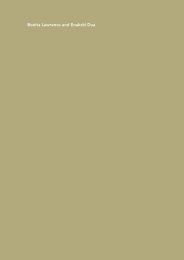Malissa Phung - Speaking My Truth
Malissa Phung - Speaking My Truth
Malissa Phung - Speaking My Truth
Create successful ePaper yourself
Turn your PDF publications into a flip-book with our unique Google optimized e-Paper software.
<strong>Malissa</strong> <strong>Phung</strong>
<strong>Malissa</strong> <strong>Phung</strong> is completing a doctorate in English and Cultural Studies at McMaster<br />
University in Hamilton, Ontario. For the past three years she has been studying postcolonial<br />
cultures and Asian Canadian literature while living about 30 kilometres from the<br />
Six Nations of the Grand River. Living in close proximity to the ongoing Caledonia land<br />
claim dispute and being part of an academic community committed to teaching and<br />
writing about anti-racism and anti-colonialism have greatly influenced the scope of her<br />
dissertation project and her activist politics. Her doctoral dissertation focuses on the<br />
ways in which representations of settler work ethic in Chinese Canadian literature and<br />
documentaries can potentially reproduce existing colonial discourses used to justify<br />
settler belonging on Indigenous lands and to maintain colonial stereotypes about<br />
Indigenous peoples that imply they are undeserving of contested lands and resources<br />
that have been misappropriated from them and their ancestors. Born in Red Deer,<br />
Alberta, to ethnically Vietnamese displaced immigrants of Chinese descent, <strong>Malissa</strong><br />
grew up mostly in Edmonton where she and her family have benefited a great deal<br />
from Treaty 6. Being the daughter of a successful hair salon owner in Chinatown—a<br />
downtown business district that intersects with an urban Indigenous population—has<br />
provided her with a complicated upbringing of racist and classist views of Indigenous<br />
peoples. In her academic and creative work, <strong>Malissa</strong> strives to unsettle these colonial<br />
views she has inherited from both her community and the dominant settler society.
Are People of Colour Settlers Too<br />
In their 2005 article, “Decolonizing Antiracism,”1 Indigenous and critical<br />
race studies scholars Bonita Lawrence and Enakshi Dua point out that “there<br />
is something deeply wrong with the manner in which, in our own lands,<br />
antiracism does not begin with, and reflect, the totality of Native people’s lived<br />
experience—that is, with the genocide that established and maintains all of the<br />
settler states.”2 Lawrence and Dua take anti-racist and anti-colonial academics<br />
and activists to task for overlooking and effectively erasing from their analyses<br />
and political projects the histories, epistemologies, and political claims of<br />
Indigenous people. They claim that anti-racist and anti-colonial academics<br />
and activists have failed to make the presence and ongoing colonization of<br />
Indigenous people in the Americas foundational to their analyses of race<br />
and racism. They argue that these elisions have narrowed theoretical and<br />
historical understandings of race and racism, particularly in Canadian antiracist<br />
discourses, which can render people of colour innocent in the ongoing<br />
colonization of Indigenous people. Though people of colour have faced and<br />
still face marginalization and exclusion in Canada, Lawrence and Dua contend<br />
that people of colour are still complicit in the ongoing land theft and colonial<br />
domination of Indigenous people.<br />
Lawrence and Dua’s work compels us to think critically about how people of<br />
colour are complicit in the colonization of Indigenous people in Canada, a<br />
problem that has often been framed as a white settler–Indigenous issue. For<br />
too long now, issues of racial discrimination and exclusion that people of<br />
colour face in Canada have been framed as a separate issue from the colonial<br />
legacies that still affect the material experiences of Indigenous people today. It<br />
is as though the fact that people of colour face discrimination and exclusion<br />
in Canada somehow means that they cannot possibly contribute to the<br />
colonization of Indigenous people as well. Or, in the case of refugees fleeing<br />
from their places of origin to escape political persecution, even if they benefit<br />
as colonial settlers, how can we blame them for settling when their main<br />
priorities lie in the basic need to survive In her groundbreaking 2007 book<br />
Exalted Subjects: Studies in the Making of Race and Nation in Canada, the<br />
feminist and anti-racist scholar Sunera Thobani forcefully argues that despite<br />
the magnitude of their dehumanization and exploitation, we cannot minimize<br />
Cultivating Canada | 291
the fact that immigrants and refugees are also participants in and beneficiaries<br />
of Canada’s colonial project, especially when they work towards achieving<br />
equality with Canadian settler subjects, thereby placing their political status<br />
above that of Indigenous people in Thobani’s triangulated theory of Canada’s<br />
racial hierarchy.3 But this issue of whether people of colour are settlers<br />
is a complicated one that requires more than just a simple recognition or<br />
acknowledgement that people of colour are complicit settlers. And so, while I<br />
agree with Lawrence and Dua’s central claim that people of colour are settlers, I<br />
have some questions about the implications of this complicated argument.<br />
If people of colour are settlers, then are they settlers in the same way that<br />
the French and British were originally settlers in Canada And what exactly<br />
does being a settler mean Is it a simple descriptive term—settler proper—or<br />
is it a term that carries historical legacies inflected differently by race, class,<br />
gender, sexuality, and ability Is it a unified monolithic subject position Or<br />
can colonial settlerhood be stratified Do different settlers operate on different<br />
levels with regard to access to power What is even more complicated is the<br />
question of mixed race settlers: if all non-Indigenous Canadians are settlers<br />
simply because they or their ancestors migrated to Canada, then what do we<br />
make of settlers who have Indigenous ancestors several generations removed<br />
Can someone who easily passes as a settler choose not to be a settler I admit<br />
these are complicated questions to ask in light of the racist and sexist legacies of<br />
the Indian Act’s marriage laws that used to determine and still does determine<br />
who is and who is not a status “Indian.”<br />
Though I may not have ready answers to these difficult questions, I would<br />
like to begin discussing their implications by questioning whether settlers<br />
of colour can be easily equated with white settlers. I am not disagreeing with<br />
Lawrence and Dua’s main argument; I am not looking for some way to mitigate<br />
the complicity of settlers of colour. Instead I am interested in what a concept<br />
like settler can do, how this concept can recalibrate the methodologies and<br />
epistemologies that anti-racist and anti-colonial academics and activists use to<br />
produce knowledge and shape public discourses in Canada—necessary steps to<br />
consider as we work towards transforming Canadian policies and institutions<br />
to more fully acknowledge and affirm Indigenous claims to national and<br />
cultural independence.<br />
If being a settler simply means being a Canadian, then how are all settlers<br />
equal when not all Canadians are equal Whether a settler is of British or<br />
French or any other European descent, depending on a whole range of factors<br />
(such as time of emigration, mix of racial background and cultural heritage, the<br />
type of English or French accent with which a settler speaks), settlers benefit<br />
292 | <strong>Malissa</strong> <strong>Phung</strong>
from the ongoing colonization of Indigenous people to differing degrees. The<br />
more assimilated a settler, the more a settler shares the dominant physical<br />
characteristics, linguistic features, and nationalistic desires of a settler society,<br />
the more a settler will be afforded the material benefits and opportunities to<br />
become productive citizens of Canada.4 Lawrence and Dua would rightly argue<br />
that when marginalized settlers of colour organize and demand equal access to<br />
citizenship rights and benefits, they risk staking colonial claims to belong and<br />
own land and resources that have been stolen through imperial land treaties<br />
that have never been fully honoured or that have been legally misinterpreted<br />
to advantage and benefit predominantly white settlers. What concerns me,<br />
however, is how we can equate the colonial status of settlers of colour with that<br />
of white settlers—how we can talk about settlers in monolithic terms when any<br />
non-Indigenous Canadian is not necessarily first and foremost only a settler<br />
If we look to the literary production of white settlers in nineteenth century<br />
Canadian literature, we can trace how settlers in Canada began to conceive and<br />
imagine their settler placement and belonging on Indigenous lands. This was<br />
also a period of colonial administration and land cession treaty negotiations<br />
that began to prioritize land acquisition and control over the establishment<br />
of peace and friendship between settlers and Indigenous people, which had<br />
originally been the primary objective of the 1763 Royal Proclamation Act.5<br />
Understanding concepts of white settlerhood during this shift in Indigenous–<br />
settler relations can shed light on contemporary settler–Indigenous<br />
relationships and reveal both the similarities and differences between<br />
contemporary people of colour and these nineteenth century colonial settlers.<br />
Nineteenth century Canadian literature was deeply invested in telling stories<br />
and devising images that worked to affirm the myth of Indigenous people<br />
as a vanishing and dying race, only to be replaced by stories and images<br />
of Indigenized white settlers; that is, Indigenous in their ability to cultivate<br />
Indigenous attributes and skills.6 Literary scholars have attributed the colonial<br />
trope of the vanishing “Indian” to white settler desires to vacate Indigenous<br />
people from the national imaginary and to overcome the unsettling knowledge<br />
that settlers would never be indigenous to this land.7 So to justify their right to<br />
occupy and belong in Indigenous territories, nineteenth century white settler<br />
writers, I would add, conveniently constructed a labour narrative of hard work<br />
and enterprise to self-indigenize; meanwhile Indigenous people, according to<br />
colonial stereotypes, have been constructed as lazy and lacking in industry and<br />
civility. Stereotypes about Indigenous people in Canada stem from the colonial<br />
notion of terra nullius: when the French first came to colonize the so-called<br />
uninhabited New World, they assumed that “since the Amerindians led a mobile<br />
life without settled abode, ‘ranging’ the land ‘like beasts in the woods’, they could<br />
Cultivating Canada | 293
not be classed as inhabitants according to European law.”8 In other words,<br />
since Indigenous people were seen as lazy, uncivilized, nomadic people who<br />
did not cultivate the land for profit, according to these settler colonial labour<br />
narratives, white settlers earned their right to the land that Indigenous people<br />
had apparently allowed to go to waste.<br />
People of colour engage in this process of indigenization when they work<br />
towards achieving, or, in some cases, have managed to achieve, upward class<br />
mobility while at the same time promoting similar settler colonial labour<br />
narratives of hard work and enterprise in the face of Indigenous claims to<br />
autochthony. Assimilated people of colour can produce similar settler colonial<br />
narratives in order to emplace their settler belonging on Indigenous lands:<br />
such narratives of immigrant origins and trials and tribulations can construct<br />
people of colour as exemplary settlers who have been able to work hard to rise<br />
above their racialized immigrant origins and succeed despite all of the odds<br />
stacked against them. But successful portraits of model immigrants and people<br />
of colour also run the risk of being mobilized to either blame marginalized<br />
settlers of colour and Indigenous people for not being able to contribute to<br />
the settler society, or to blame model minorities for taking away jobs from<br />
Canadian settler subjects. I will now turn to a particular group of settlers to<br />
further address these tensions.<br />
Chinese indentured labourers were constructed in nineteenth century<br />
Canadian culture as a “model minority” group. Stereotypes of Chinese<br />
labourers as hyper-industrious labour machines willing to work for next to<br />
nothing abound in historical records, newspapers, government publications,<br />
and immigration debates at the time. These positive stereotypes came<br />
hand-in-hand with negative stereotypes as Chinese settlers circulated in<br />
mainstream Canadian representations as the “yellow peril.”9 Furthermore,<br />
Chinese labourers represented a racial and moral threat to the national<br />
fabric and an economic threat appropriating resources that rightfully, it<br />
is argued, belong to hardworking industrious white settlers when, in fact,<br />
these resources more rightfully belong to Indigenous people.<br />
For example, from the 1870s to the Great Depression, white labour leaders<br />
lobbied for restrictive and racially discriminatory immigration policies to<br />
protect the standards of living of white Canadian workers; they conceived<br />
of Asians as “degraded workers who were unfair competition to white<br />
Canadians.”10 More recently, there was also the racist W-Five news exposé,<br />
“Campus Giveaway,” broadcasted on CTV in 1979 on the supposed mass<br />
displacement of hardworking white Canadians from highly competitive and<br />
lucrative programs such as pharmacy, computer science, engineering, and<br />
294 | <strong>Malissa</strong> <strong>Phung</strong>
medicine by foreign international students, who were represented in the<br />
segment with images of Chinese Canadian university students.11 A much more<br />
recent reiteration of the “yellow peril” discourse is the problematic coverage<br />
of a perceived Asian hyper-enrolment and unfair Asian–white competition<br />
in Canadian universities in the Maclean’s 2010 article “Too Asian” Stephanie<br />
Findlay and Nicholas Köhler’s article sparked rigorous public debate and<br />
mobilized public calls to action from Asian Canadian citizens, academics,<br />
and activists across the nation in blog posts, newspaper articles, online<br />
commentary forums, and community meetings.12 These long-standing racial<br />
and class inter-settler tensions suggest that there are multiple ways of being<br />
configured as an invasive settler. Although they may occupy Indigenous lands<br />
and benefit from the displacement of Indigenous people, Chinese settlers<br />
have also been figured as perpetually foreign or alien, unsettled settlers<br />
posing an invasive threat to the livelihoods of Indigenized white settlers. As<br />
this kind of historical analysis demonstrates, Chinese settlers cannot simply<br />
be equated with the original British and French settlers, either at the level of<br />
representation or at the level of material experience.<br />
I have included the case of Chinese settlers in my discussion for several<br />
reasons. First of all, Canadian literary and visual representations of<br />
Chinese labour and colonial settlerhood constitute the main subject of my<br />
Ph.D. dissertation. I am interested in exploring what it means to represent<br />
the history of Chinese exclusion and marginalization in Canada and to<br />
formulate anti-racist discourses without being grounded in the history of<br />
Indigenous exploitation and oppression in Canada. Second, as a middleclass<br />
female junior academic settler born to Sino–Vietnamese immigrants<br />
in what is now known as central Alberta, I have benefited a great deal from<br />
Treaty 6.13 This essay constitutes a reflection of my own complicity as a<br />
racialized Canadian settler subject. Because of Treaty 6, my immigrant<br />
family has been able to improve their socio-economic status and send me<br />
and my brother to university. Though I may have experienced my fair share<br />
of racial and gender discrimination throughout my life, I never had to worry<br />
about my employers making negative assumptions about my work ethic or<br />
productivity since positive stereotypes about Asians being hard workers<br />
and exceptional at math would exaggerate my physical and intellectual<br />
capacity. Given the inequity of these settler privileges and treaty benefits<br />
that my family and I enjoy, through my scholarly research I have come to<br />
be politically and ethically committed to undermining the ways in which<br />
anti-racist discourses regarding settlers of colour, particularly Chinese<br />
settlers, become mobilized among diasporic communities to stake claims<br />
of national belonging and acceptance.<br />
Cultivating Canada | 295
Not only have I drawn on Lawrence and Dua’s critical intervention but I have<br />
also nuanced the ways in which the entry of settlers of colour to Canada has<br />
put them in colonial relationships with Indigenous people. I recognize that<br />
relying on monolithic notions of the term “settler” runs the risk of reducing<br />
settler–Indigenous relations to overly simplistic binary models of thinking.<br />
If we lump all non-Indigenous people into a single category of settler, then<br />
do we risk erasing and subsuming the different histories and everyday<br />
experiences of settler privilege and marginalization from which white<br />
settlers and settlers of colour come from As I said before, the questions and<br />
concerns I have been raising thus far are not meant to mitigate the complicity<br />
of settlers of colour; rather, I raise these complexities as part of a solidarity<br />
exercise that aims to recuperate the term settler as a politicized identification<br />
for white settlers and settlers of colour.14 I am interested in invoking an<br />
anti-colonial conceptualization of the term “settler” that both recognizes<br />
non-Indigenous complicity in Canada’s ongoing colonial project and stands<br />
in solidarity with the decolonization projects of Indigenous people. To selfidentify<br />
as a settler rather than as a Canadian does not necessarily negate the<br />
rights and benefits of citizenship that settlers have come to accrue as a result<br />
of settler colonialism. But mobilizing all settlers to become aware of the ways<br />
in which their settler privileges are anything but natural and well deserved<br />
can constitute a first step in supporting Indigenous activism against settler<br />
domination.<br />
I conclude this essay with an example from New Zealand/Aotearoa. Pakeha,<br />
the Maori word for the descendants of European colonizing settlers, came to<br />
invoke a particular form of politics in New Zealand, one which recognized<br />
Maori claims to sovereignty, was built on a revisionist conception of New<br />
Zealand’s colonial history, and was sensitive to Maori claims of institutional<br />
racism within New Zealand society.15 Somewhat equivalent to the term<br />
“settler” in Canada, the Maori word pakeha has been a source of contention<br />
in race politics in New Zealand. In the 1990s, non-Maori committed to an<br />
anti-racist politics began to self-identify as pakeha on a wider scale, whereas<br />
those who opposed the term opted for “New Zealander.”16 At one point, this<br />
term generated such extensive opposition that there was a call by a member of<br />
Parliament to ban public use of the word.17<br />
I bring up this example of a politicized concept of settlerhood not to propose<br />
that the term “settler” can do the same political work that the Maori word does<br />
in New Zealand since the English term is rooted in a colonial language. I am<br />
merely suggesting that perhaps the term “settler” can aspire towards doing<br />
the same type of history work that the term pakeha does. When we identify<br />
as settlers or pakeha, we acknowledge where we actually come from—not<br />
296 | <strong>Malissa</strong> <strong>Phung</strong>
here. Settlers of colour and pakeha of colour are already quite aware that they<br />
are not from here, or that they have never truly belonged here. But given the<br />
propensity of settlers to retell enduring labour narratives of rightful occupation<br />
and belonging on this land, thereby overwriting the fact of this land being<br />
Indigenous territory, I can only ask that political allies of Indigenous people<br />
remain vigilant and committed to working towards undermining such “selfindigenizing”<br />
narratives within their own settler communities.<br />
Notes<br />
1 Reprinted elsewhere in this volume.<br />
2 Lawrence, Bonita and Enakshi Dua (2005:121). Decolonizing antiracism. Social Justice<br />
32(4):120–143.<br />
3 Thobani, Sunera (2007:16–17). Exalted Subjects: Studies in the Making of Race and<br />
Nation in Canada. Toronto, ON: University of Toronto Press.<br />
4 I owe my conceptualization of settler privilege to the way in which Ross Chambers<br />
discusses white privilege as a set of cards one is dealt. He describes identity as a poker<br />
hand, “in which the value of the ace (whiteness) can be either enhanced, if one holds a<br />
couple of court cards or another ace (masculinity, heterosexuality, middleclassness…),<br />
or alternatively depreciated by association with cards of lower value (ethnicity,<br />
color, lack of education, working-classness…).” See: Chambers, Ross (1996:144). The<br />
unexamined. The Minnesota Review 47:141–156. Settler privilege can likewise be<br />
enhanced or depreciated, but to the degree of assimilation a settler exhibits.<br />
5 Dickason, Olive P., with David T. McNab (2009:156–157). Canada’s First Nations: A<br />
History of Founding People from Earliest Times. (4th ed.). Don Mills, ON: Oxford<br />
University Press.<br />
6 Johnston, Anna and Alan Lawson (2006). Settler colonies. In Henry Schwarz and<br />
Sangeeta Ray (eds.). A Companion to Postcolonial Studies. Malden, MA: Blackwell:<br />
360–376.<br />
7 See: Goldie, Terry (ed.) (1989). Fear and temptation. In Fear and Temptation: The Image<br />
of the Indigene in Canadian, Australian, and New Zealand Literatures. Kingston, ON:<br />
McGill-Queen’s University Press: 3–18; Johnston and Lawson (2006).<br />
8 Dickason with NcNab (2009:146).<br />
9 The term “yellow peril” was originally devised by Kaiser Wilhelm of Germany, who<br />
used it to foster racial discrimination, and was later used to describe the supposed<br />
danger of Orientals overwhelming the West. For more on this topic in another settler<br />
society context, see: Walker, David (1999). Anxious Nation: Australia and the Rise of<br />
Asia 1850–1939. St. Lucia, AU: University of Queensland Press.<br />
10 Goutor, David (2007). Guarding the Gates: The Canadian Labour Movement and<br />
Immigration, 1872–1934. Vancouver, BC: UBC Press.<br />
11 Chan, Anthony B. (1983). Gold Mountain: The Chinese in the New World. Vancouver, BC:<br />
New Star Books.<br />
12 For the original article, see: Findlay, Stephanie and Nicholas Köhler (2010). Too Asian<br />
Maclean’s 123(45):76–81. For an astute analysis of Findlay and Köhler’s xenophobic<br />
article, see Jeet Heer’s online commentary in The National Post: Heer, Jeet (2010,<br />
November 15). Maclean’s article on Asians familiar to anti-Semites of old. The<br />
National Post (retrieved 29 December 2010 from: http://fullcomment.nationalpost.<br />
com/2010/11/15/jeet-heer-macleans-article-on-asians-familiar-to-anti-semites-ofold/);<br />
See also his blog-post for The Walrus at: Heer, Jeet (2010, November 24). Too<br />
Cultivating Canada | 297
Brazen: Maclean’s, Margaret Wente, and the Canadian media’s inarticulacy about<br />
race. The Walrus Blog. Retrieved 29 December 2010 from: http://www.walrusmagazine.<br />
com/blogs/2010/11/24/too-brazen/<br />
13 Signed in 1876 between delegates representing the British Crown and Plains Cree<br />
and other Indigenous people such as the Nakoda, Salteaux, and Chipewyan, Treaty 6<br />
ceded the Indigenous territory now known as central Alberta and Saskatchewan for<br />
colonial settlement.<br />
14 Throughout this essay, I have been employing the seemingly benign and neutral term<br />
“settler” rather than “settler-invader,” which was first adopted by colonial and postcolonial<br />
scholars in the 1980s to emphasize the physical violence and representational<br />
erasure exacted on Indigenous communities that the more benign and seemingly<br />
neutral term “settler” conceals. In the Canadian context, I use the term “settler”<br />
not to mitigate these historical violences but to acknowledge Indigenous agency<br />
and sovereignty and to avoid affirming the colonial discursive myth of conquered<br />
vanishing Indigenous people when the history of Indigenous displacement and<br />
dispossession in Canada was more a result of legal imperialism than outright military<br />
conquest. See: Stasiulus, Daiva and Radha Jhappan (1995). The fractious politics of<br />
a settler society: Canada. In Daiva Stasiulus and Nira Yuval-Davis (eds.). Unsettling<br />
Settler Societies: Articulations of Gender, Race, Ethnicity and Class. London, UK: Sage<br />
Publications: 95–131.<br />
15 Larner, Wendy and Paul Spoonley (eds.) (1995:51). Post-colonial politics in Aotearoa/<br />
New Zealand. In Unsettling Settler Societies: Articulations of Gender, Race, Ethnicity<br />
and Class: 39–64.<br />
16 Larner and Spoonley (1995:52).<br />
17 Larner and Spoonley (1995:52).<br />
298 | <strong>Malissa</strong> <strong>Phung</strong>

















